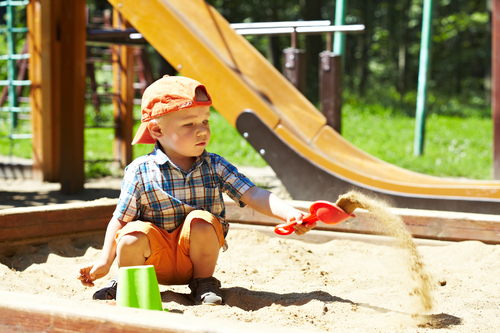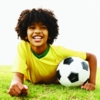Playground Safety
With the warmer weather upon us, more and more children are participating in outdoor activities. Playgrounds are a favorite place for many children to spend their time, and it is important for their caregivers to be aware of how to best keep them safe.

Each year over 200,000 children are treated in an emergency room for playground related injuries, many of which can be prevented with proper supervision and the right information. Children should always be supervised by an adult, who can insure that children use the playground equipment for its intended use and can provide the proper care should injury occur.
Playground safety starts with the proper environment. Sand, wood chips, or rubberized matting should be on the surfaces under swings, seesaws, and jungle gyms. Concrete, asphalt, and blacktop are unsafe materials. Keep in mind that cushioned surfaces should extend at least 6 feet past the equipment.
Parents should always inspect all equipment in the playground before allowing children to play. Wooden equipment should not be splintering and metal equipment should not be rusting. Fencing around the playground should be intact. The surface materials should be loosely packed and covering all spaces. Hardware should be secure and not sticking out or cracked. Make sure to feel the surfaces of the equipment, as they can become quite hot during the summer months, and if too hot, may cause a contact burn within seconds.
The equipment in a playground should be designed for children of at least three different age groups, with some equipment for infants and toddlers under 2, some for 2 to 5 years old, and some for school aged children. A good playground will have these areas well separated from each other with clear designations. All pieces of equipment should have guardrails and barriers on the elevated surfaces.
Equipment with moving parts such as swings and see-saws should not be located near stationary equipment. These areas should always be checked for pieces that could easily pinch a child’s finger or hands. Swings should be limited to 2 in each bay, with swings designed for infants in a bay separate from other swings.
It is also important to teach children the proper way to use playground equipment. Children should know not to roughhouse on any equipment. While on a swing, children should be taught to sit only while holding on with both hands. They should make sure the swing has stopped moving before getting off and should be careful not to run or walk in front or back of a swing when another child is using it. Only one child should ride on a swing at any time. If using a see-saw, children should sit one to a seat, with feet to the sides, and always facing forward. Partners should be matched in weight to prevent abrupt contact with the ground.
Climbing equipment is a newer addition to many playgrounds. Adult supervision is always important for these pieces. Keep in mind that preschool aged children may not have the upper body strength to climb up or down such equipment, and that all children should find a safe route down if they feel they cannot climb. They should always use both hands and leave enough distance between themselves and the children in front of them. If they jump off, they should bend their knees and land on both feet. Children should make sure that they do not begin a climb if the equipment seems full.
Slides also present their own set of dangers. Children should know to hold onto the handrail when climbing the ladder and that they should take one step at a time. They should not try to climb up the slide itself, and should always go down the slide feet first, while sitting up. They should always make sure that the bottom area of the slide is clear of other children before sliding down, and should walk away as soon as their turn is done. Adults should also be aware of the potential they have to injure children when the ride the slide with them. Caregivers may feel that it is safer to have a toddler ride on their lap rather than to allow the child to ride the slide alone. This, however, may actually lead to injury, specifically a broken leg. A recent study found that almost 14 percent of pediatric leg fractures in an 11 month period were the result of a toddler younger than 3 years old, riding down a slide with a parent. If a child is sliding alone and his or her foot gets caught, the child can stop and twist to free it. When the child is sitting in an adult’s lap, the weight of the adult creates a larger force, which prevents the child from stopping and being able to move his or her leg. This may also occur when the children are wearing sneakers, which may become stuck on the side of the slide. If a parent feels that a child cannot ride safely alone from the top of the slide, they should instead be placed at the halfway point with the adult standing next to the slide. If an adult must go down the slide with the child, they should at least remove the child’s sneakers and make sure their legs do not touch the sides or sliding surface.
Playing outside is important to help develop a child’s physical, intellectual, social, and emotional skills. When children and adults are aware of how to use a playground safely, this will minimize the risk of injury and accidents, and everyone will have the best possible experience.
Featured Blogger
Leslie Greenberg

Leslie Greenberg, MD, FAAP is a general pediatrician practicing with Princeton Nassau Pediatrics. She graduated from Brandeis University magna cum laude with a BA in sociology. She attended medical school at Tufts University School of Medicine and completed her residency training at The Children's Hospital of Montefiore in the Bronx, NY. She currently lives in the West Windsor, NJ area with her husband and two sons. She has been with PNP since 2009. Princeton Nassuau Pediatrics is a group of board certified general pediatricians whose mission is providing the highest level of health care to the children of the greater Princeton, West Windsor, Monroe, and Pennington areas. The group provides state of the art care for children from infancy through college based on the most up-to-date medical advances. PNP has four locations, and offers routine well care visits, same day sick visits, weekend/holiday and evening urgent care coverage, as well as full in-office laboratory services. Visit www.princetonnassaupediatrics.com.




























